Chapter 1: Cultural Clues in Old Graveyards
Four basic materials, wood, clay, stone, and concrete, formed North Carolina gravemarkers from the eighteenth to the twentieth centuries. ... [Artisans] used wood for railings, graveboards, and gravehouses, ... p 4
Figure 1.2.
(2) headboard and footboard; ... p 5 |
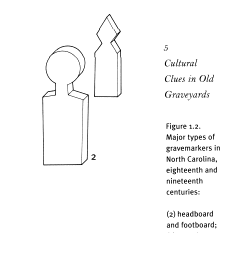 | 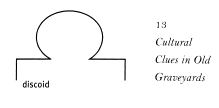 |
WOODEN MARKERS
The use of wooden gravemarkers is a European tradition as well as an American one. The graveboard (post and rail gravemarker) was common in Great Britain and New England from the seventeenth century into the nineteenth century. In two regions of England where there is no local stone, East Anglia and Surrey, wood was the most common gravemarker material until the twentieth century. Wooden markers were never much valued; a historian of Scottish headstones dismissed the graveboard as "a mere gravedigger's marker," and there is evidence in North Carolina estate records that it was indeed often the case that the gravedigger not only made the coffin, but supplied the gravemarker as well. Wood was the most easily available and relatively inexpensive material in North Carolina for gravemarkers, thus various wooden markers probably populated North Carolina cemeteries from the earliest settlement to the early twentieth century. Few wooden gravemarkers survived in 1981 when this fieldwork commenced, since wood is a perishable material, and most wooden markers succumbed to rot, fire, or replacement by a more permanent marker.
Headboards and Footboards.
Artisans often fashioned wood into substantial wooden markers: headboards, footboards, and graveboards. Graveboards, having the shape of the headboard of a bed, are not known in North Carolina. Headboards and footboards are narrower, having the proportions of a headstone. The typical headboard is 6 inches wide, 16 inches high, and 1½ inches thick. In the Coastal Plain, woodworkers preferred cypress, cedar, or heart pine, the same rot-resistant /p 6/
woods used for fence posts, for gravemarkers, and a number of head and footboards still exist in rural graveyards, some with traces of white paint. Although people probably erected head and footboards more often than any other type of gravemarker in the eighteenth and nineteenth centuries, few have survived because of destruction by weathering, fire, or replacement with a gravestone (Fig. 1.4).
The wooden headboard and footboard have flat surfaces capable of carrying an inscription, either carved or painted. Family members probably made most of the boards, but numerous artisans also made them. The largest known headboard in North Carolina, at Longstreet Presbyterian Church, Hoke County, is 10½ inches wide, 39½ inches high, and 2 inches thick. Those with money could buy them from craftsmen like William R. Hughes, who operated a chair and bedstead manufactory but stipulated in his advertisement in the Salisbury Western Carolinian, 27 May 1833: "In connection with his business, he will also make head and foot boards for Graves, complete; lettered or plain." Itinerant limners and coach painters probably painted boards as one of many sidelines. p 7
Figure 1.4. [wooden] Headboard measuring 7" wide, 27" high, and 2¾" thick, Old Burying Ground, Beaufort. This probably dates from the nineteenth century.
---
Chapter 6: The Living Vernacular: twentieth-century traditional white and African American markers
North Carolina's agricultural economy and rural population dispersal has preserved the traditional nature of many communities up to the present, and in family graveyards and country churchyards, sometimes by necessity, sometimes by choice, people still create their own gravemarkers.
White graveyards contain grave mounds, shell graves, wooden head and footboards, concrete monuments, grave fencing, and customized granite monuments. Traditional white artisans attempt to follow commercial monument design in their handcrafted concrete monuments. ... [Traditional African American artisans] use ephemeral materials such as shells and bric-a-brac, commercial metal and plastic items intended for functional household use, concrete, or perishable materials such as sculpted earth and wood. p 237
Beulah Churchyard, located in the Coastal Plain, contains bare sand, flowering shrubs planted around the graves, and a fence separating it from the flat farm fields beyond. Each grave is /p 239/ marked by a wooden head and footboard, ...
WOODEN HEADBOARDS AND FOOTBOARDS
Head and footboards continued to be used until at least the 1940s. Several generations of the Horne and Hair families in east Cumberland County near Autryville made coffins and head and footboards. Enoch Arthur Horne, active in the early twentieth century, made coffins. His son, Enoch Leslie Horne, made head and footboards for the M. Lee Funeral Home in Fayetteville until the 1940s. William Streeter Hair, an early-twentieth-century cooper, made "fat lightwood" graveboards from the stuumps and roots of longleaf pine trees of the area.(5) A simple squared-off headboard in Cumberland County in probably typical of early-twentieth-century headboards, although its inscription, in neat lettering that appears to be burned into the wood, is atypical (Fig. 6.7).
(opposite) FIgure 6.7. Headboard of F. Dees, d. 1908, Adcox Graveyard, Cumberland County. (Photo by M. Ruth Little, Southern Folklife Collection, Wilson Library, University of North Carolina at Chapel Hill) p 242
Widespread poverty in the rural South allowed few families to purchase marble gravestones at the turn of the century, and a large pent-up demnad for gravemarkers would have existed. Families probably bought many of these markers in the 1920s to mark old graves. Often these concrete headstones have the earliest death dates in the graveyard because fieldstones or uninscribed headboards mark older graves. p 245
African American Traditions
WOODEN HEADBOARDS
Wooden gravemarkers occur as commonly in African American graveyards as in white graveyards, and generally follow the same symmetical forms. But the bold wavy-sided contour of this headboard for an unknown black person in the piney backwoods of Lee County represents the African American delight in asymmetrical, flowing form (Fig. 6.12). The unknown artisan who sawed out this headboard created a remarkable deviation from the traditional form.
Figure 6.12. Headboard, Green Grove AME Zion Churchyard, Lee County (Photo by J. Daniel Pezzoni, 1991; North Carolina Division of Archives and History)
- M. Ruth Little, Sticks and stones: three centuries of North Carolina gravemarkers (UNC Press 1998)
|
Following the battle of Franklin, November 30, 1864, ... Most of the over 1,750 Confederate dead were buried on the battlefield, their graves marked by wooden headboards inscribed with the soldier's name, company, and regiment. Over the months, the writing faded, and the markers began to disappear. - Carnton Plantation, Franklin TN
Six hundred Confederate soldiers who died in Warrenton [Virginia] field hospitals following the Battles of First and Second Manassas have rested in anonymity in the town's cemetery since 1877, when their bodies were removed from their unmarked graves and reinterred beneath a granite shaft erected in their honor ... Although each soldier had originally been identified by a wooden marker made by local schoolchildren, Union troops callously pulled up the the makeshift headstones and burned them for firewood in the winter of 1863. The names of Warrenton's Confederate dead were thus lost to history. - Warrenton Cemetery, Virginia
It is impossible to be certain how many graves are here, due to rotting wooden grave markers, heavy brush, etc., but I would venture that at least 30 graves exist here ... [15 wooden grave markers - illegible] - Bowman Cemetery, Table Rock Lake, Stone County, Missouri
A number of wooden grave markers were burned when a fire got away from a farmer who was burning off the land. ... The wooden grave markers for Elisha Holland, Patience Watkins and Patie Peacock were destroyed by fire in the 1960's. - Elisha Holland Cemetery, Pinkney in Wayne County, North Carolina
An iron gate blocks the road into the cemetery, which is carved into about two acres of land nestled in the tall pines of the northern part of the county. A cement wall was erected around the cemetery more than 100 years ago to shield it from the fires that previously had devastated the wooden grave markers. One wooden marker survives and is believed to be about 200 years old. - Pensacola, FL May 30, 2003
According to the Inventory of Effects of a Deceased Soldier, Private Milo Taylor had no effects to be returned to his family. His grave along with some 3000 other Union and Confederate Soldiers were marked by wood grave markers. In 1868, by an act of Congress, the Mississippi River Cemetery was renamed the National Cemetery of Memphis. In 1868-1869, the wood grave markers where removed and stone markers was set in there place. Each stone was marked in "CHALK" showing name, rank, unit and date of death of each soldier. Before the stone cutters could complete there work, it rained, washing away the "CHALK" notations. All of these grave markers are now found bearing only the inscription "UNKNOWN SOLDIER." - 48th OVVI Veteran Milo Taylor, (48th Regiment Ohio Volunteer Infantry)
"On this site, 1861-1865, are buried several hundred Union and Confederate soldiers, killed in the Western campaign. Lack of interest from distant families allowed deterioration of the wood grave markers and heavy overgrowth. In 1927, the Jeffersonville Council determined, 'Better the sound of children's footsteps at play than the silent stride of the nearly forgotten great spirit army here at rest.' The only intact stone marker was moved to Walnut Ridge Cemetery. No bodies were exhumed." - large stone marker, Civil War Cemetery, Jeffersonville Township, Clark County, Indiana
At war's end, responsibility for Freedmen’s Cemetery was transferred to the new Bureau of Refugees, Freedmen and Abandoned Lands. When Congress curtailed nearly all Freedmen’s Bureau’s functions at the end of 1868, the cemetery, with its more than 1,700 burials, was closed. The parcel’s former owner, attorney Francis Smith, reclaimed it. For eight decades, it remained largely undisturbed, but the wood grave markers quickly rotted away. - Freedmen's Cemetery, Alexandria, Virginia
There are 76 native stone and wood grave markers visible throughout the cemetery and several depressions where graves were most likely present. -
Barrett Cemetery, eventually renamed Winfield Cemetery, Titus County, Texas
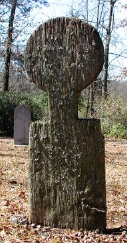 |
<-- Piney Grove Baptist Church,
Dillon County, South Carolina
aka Fat Lighter Wood Marker
aka tombstick
A lone wooden marker, cut in a typical
North Carolina "head & shoulders" design,
leans against a tree and waits to disappear.
There are three or four additional illegible markers here.
-
McNeill/McEachin Family Cemetery,
Scotland County, North Carolina -->
|
| 
|
MARY QUARTERMAN (Location B 8) - Wooden Marker Replica - original marker in Midway Museum.
SARAH WINN (Location B 11) - Wooden Marker Replica - original marker in Midway Museum.
- Midway Church Cemetery, Midway, Georgia
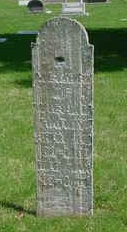 This wooden marker for William Hardy (1890-1894) was erected as a temporary marker to be eventually replaced by a stone monument. It is the only wooden marker left in the cemetery and marks an earlier period in our local history. - Cemetery Historical Tour, Logan, Utah -->
This wooden marker for William Hardy (1890-1894) was erected as a temporary marker to be eventually replaced by a stone monument. It is the only wooden marker left in the cemetery and marks an earlier period in our local history. - Cemetery Historical Tour, Logan, Utah -->
Currently, all that remains of the town of Clarksville [California] are a few scattered dwellings. The ruins of a few stone buildings mark the former site of the post office. A few wooden houses, weathered beyond livability, also stand in the area. The only property to survive relatively undamaged by time is the Clarksville Cemetery. With its fence intact, its marble and wood grave markers still legible, the cemetery bears mute witness to the hard work of generations of human caretakers. - Clarksville Cemetery, California
After the teen's family moved, her efforts were followed up by Jack Hays. The retired Prosser resident, who had recently moved from Kennewick, started by mowing the lawn. Then he replaced the splintered wood grave markers with concrete crosses. - Prosser, Washington
For the less wealthy, the usual form of marker was a simple wooden headboard. There were many of these around Ross Bay Cemetery, but wood decays, and the last surviving wooden marker was replaced in 1983 with a stone one. - Ross Bay Cemetery (1873- ), Victoria, British Columbia, Canada
JOHN "Jack" KILLOUGH, probably born at Yell Hill [38 miles northwest of Belfast, Northern Ireland] ca. 1760/70; m. Nancy Rea, aunt of the Mary Ann Rea who went to Canada with her husband James. Yell Hill family burials are believed to be in Finvoy, near Ballymoney, but no church records have been found; only wood grave markers were used then and none have survived. - an Irish genealogy
After the Great War, many Belgian communities had a German WW1 cementries. ... The community of Langemark had in total 17 German cementries. Of of these was called 'Langemarck-Nord' or 'Nr. 123' located at the Klerkenstraat.
The graves were marked with heavy wooden crosses. These were replaced in 1957-'58 by numbered stone monuments.
The temporary markers were abandoned, most disappeared but a few were retained by Belgian museums and collectors of the period. - WW1 German Wooden Grave Markers
Stone grave markers apparently were not used at Bethany, and graves were
either marked with wooden slabs, or they had no markers at all. The use of wooden markers, usually heart pine, was common within the Ebenezer settlement. Wooden markers of this type are preserved at the Jerusalem Church, Zion Church, Goshen, and Plantation cemeteries (Dasher Creek), as well as at several small family cemeteries in the Effingham County. Elder residents of Effingham County recall seeing similar markers at Bethany. However, no traces remain above the ground surface. p6
A plan map was made showing the outlines of 11 probable human graves within the machine stripped area (Figure 4). Copies of this map were sent to the Bethany Cemetery Restoration Committee so that historically authentic wooden gravemarkers, dubbed "tombsticks", could be erected at the head and foot of each grave. p10
- Bethany Cemetery: Two Seasons of Investigation. By Daniel T. Elliott, 2000 (.04 MB). Lamar Institute Report: Bethany Cemetery, Effingham County, Georgia. Ebenezer Archaeological Report Series, Number 2, by Daniel T. Elliott and Rita F. Elliott, Athens, Georgia, August 1989.
... Some members of this family
are buried in a secluded wooded area in unmarked graves almost
directly across the road from the old homestead of Lula and Nathan [Thrift].
The overgrown area has been owned in the past by timber companies, but
now is owned by Clyde and Mamie (Thrift) Sands who protect the burial
plots with a fence. At this writing, known burials in the cemetery
were those of John and Newt Sands, Salley, Spencer and Felton Sands.
Outside the area, but near the
homesteads are two babies of George W. Sands (no names or sex., known)
and three babies belonging to the James (Jim) Sands families, one girl
and two boys, unnamed. one child was buried in a shoe box and another
was in an ammunition box according to living relatives. Mamie Sands
remembers attending the funeral of Spence. Aaron Thrift once burnt the
woods and the wooden markers depicting the grave sites were destroyed
in the fire. - "Once Upon a Lifetime: in and Near Baker County, Florida," v.2
CEMETERIES - WALNUT HILL CEMETERY, VERNON PARISH, LOUISIANA
...
NOTE: Until about the late 1800’s, graves were marked with wooden markers which quickly rotted and disappeared. Therefore, no Bedsole graves were found in the older cemeteries. - Cornbread and Grease: A Bedsole History Summary 1690-1990
|
The same love of artistry evident in the homes of Blacksburg's early townfolk can be seen in the monuments that marked their final resting places. The town trustees established a town cemetery on Roanoke Street in the early 1800s, and farm families who lived in areas now absorbed into the town set out small family burial plots on their own land. Poor families marked the graves of their deceased with crude fieldstones or wooden planks, but the more affluent could afford carefully carved stone monuments. Many of the latter were made by B. F. Spyker, a professional stone carver who operated regionally beginning in the 1820s (his work survives also in Christiansburg and Lewisburg, West Virginia). Spyker's monuments have the flavor of illuminated German fraktur manuscripts, with robustly carved flowers and foliage filling every square inch of surface. Popular motifs such as covered urns and weeping willows appear, as do Greek Revival floral devices and, on one stone, an archway supported by columns with stylized Ionic volutes similar to those that once graced the 1840s Methodist Church.
The Spyker monuments often use the common antebellum discoid form, with a round "head" on top of a rectangular "body" -- perhaps at some point in the distant past an intentional and meaningful anthropomorphism. The headstone of Arabella Peck (1836-1849), located in Blacksburg's town cemetery, shares the form. The wispy daisy-chain borders and fringed designs carved onto Peck's stone by its unknown maker -- so different from Spyker's densely-packed and robust style -- have a poignant appropriateness for the grave of a little girl. As the nineteenth century progressed, the vernacular exuberance of Blacksburg's antebellum gravestones came to be replaced by standardized forms and ornament typical of cemeteries in other parts of the nation.
- J. Daniel Pezzoni, "Blacksburg: An Architectural Overview," chapter 5, A Special Place for 200 Years: A History of Blacksburg, Virginia, Clara Cox, editor (Blacksburg 1998)
Civil War
Chattanooga, Oct. 18th, 1863
Corporal Joseph M. Raymond, Company I, 101st Ohio Volunteer Infantry
writing about the death of 1st Lt. Isaac P. Rule, Company I. 101st Ohio Volunteer Infantry who "was wounded in the fight for east Vineyard field, September 19, 1863. He died at the division hospital at Crawfish Springs on September 20, 1863, and was buried somewhere on the grounds of the Lee-Gordon Mansion. He was exhumed after the siege of Chattanooga and his remains returned home. He now rests in Pleasant Hill Cemetery on State Route 101, approximately 10 miles outside of Tiffin, Ohio."
I had some hopes that he might get better, until Sunday afternoon, when he began failing fast, our forces began falling back to this place, and strong fear were entertained of the enemy coming upon us before the train could be got away. I was determined to stay with him to the last, which I did doing all I could to alleviate his sufferings. He died at six o'clock, just as a Regiment of rebel cavalry rode up to the hospital, which was surrendered to them.
Monday we buried him, with about twenty others who had died at the hospital. I marked his grave with a piece of plank, on which I carved his name in full, and should every outward mark be obliterated, I think I could find his grave.
---
ESTABLISHMENT OF NATIONAL CEMETERIES
... The nucleus of a future system included only a few elements of a whole; that is, cemeteries in the Washington military area and those on the sites of great battles. It became necessary to extend the system to areas determined by distribution of the war dead.
First, quartermaster officers, acting in accordance with their responsibility for construction, repair, and maintenance at army installations, took over the management of post burial grounds. Second, the customary method of marking graves in frontier communities (a headstone fashioned of hard wood and bearing a suitable inscription) came into general usage. Third, surviving copies of old post cemetery registers, many of which are now preserved in the National Archives, indicate the existence of a fairly uniform system of recording burials. This recording system included, in some instances, the notation of assigned grave numbers in plots and name lists corresponding to those inscribed on headboards.
SEARCH AND RECOVERY PROGRAM
... The reburial program was initiated within two months of Lee's April 9, 1865 capitulation at Appomattox. Captain James M. Moore, the founder of Arlington and Battleground National Cemeteries, proceeded to the battlefields of the Wilderness and Spotsylvania Court House to superintend the interment of remains of Union soldiers yet unburied and mark their burial places. Similar measures were taken in the West. On June 23, Chaplain William Earnshaw, Superintendent of the Stones River National Cemetery in Murfreesboro, Tennessee, was instructed to take charge of the work of disinterring and reinterring remains in the Stones River National Cemetery. Due to excessive heat, field operations were suspended until October.
Captain Moore identified and marked, with newly inscribed wooden tablets, the graves of 700 Union soldiers. The unidentified dead were marked by tablets inscribed "Unknown U.S. Soldier." He made 800 identifications on the Wilderness Battlefield and 700 at Spotsylvania Court House; the 1,500 was only 26% of the 5,350 fatalities suffered on these fields.
...
During hostilities, the cost of maintaining wooden headboards had suggested that a more durable type of marker should be provided. Quartermaster General Meigs, in his annual report of 1866, proposed an economical solution. "A design," he stated, "has been adopted for a small cast-iron monument, to be protected from rust by a coating of zinc, to have in raised letters cast in the solid, the name, rank, regiment and company of each soldier or officer. One of these will be placed at the foot of every grave and will remain when the wooden headboards decay and perish." Prompted no doubt by hopes of including a permanent marker program within regular appropriations, General Meigs stoutly resisted every proposal for marble or granite slabs in place of his unsightly design.
HEADSTONES, GRAVE MARKERS
Another provision of the Act of February 22, 1867, directed the Secretary of War to cause each grave to be marked with a small headstone or block. The Act committed Congress to a constructive fiscal policy, with landscaping and other improvements being met by an annual appropriation. The extraordinary cost of erecting permanent grave markers required a special appropriation of Congress. During hostilities, the cost of maintaining wooden headboards had suggested the long-range economy of providing a more durable type of marker. In his annual report of 1866, the Quartermaster General stated that a design had been adopted for a small cast iron monument, to be protected from rust by a coating of zinc, to have in raised letters cast in the solid the name, rank, regiment, and company of each soldier or officer. One was to be placed at the foot of every grave and would remain when the wooden headboard decays and perishes. Although required by law, no progress was made until Congress, on March 3, 1873, appropriated $1,000,000 for the erection of a headstone at each grave in the national cemeteries to be made of durable stone and of such design and weight as shall keep them in place when set.
FENCES AND WALLS
The Act of February 22, 1867, also provided for a year-by-year improvement in landscaping and such facilities as became necessary for security and administration. Remarkable progress toward completing a long-range program of physical improvement characterized the third phase of development during the 1880's and 1890's. Burial grounds that first presented an unsightly appearance of bare mounded graves, wooden headboards, picket fences and frame buildings had been transformed by structures of iron, stone and marble.
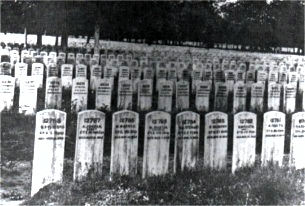 Andersonville Cemetery Andersonville Cemetery
<-- This photo, taken shortly after the Civil War, shows the wooden markers which were erected under the direction of Clara Barton. Andersonville became a National Cemetery on August 17, 1865.
Completing his reconnaissance of the Wilderness battlefield, Captain Moore went on to Spottsylvania Court House, where he identified and marked with newly-inscribed wooden tablets the graves of 700 Union soldiers. The unidentified dead were marked by tablets bearing the inscription "Unknown, U. S. Soldier." In all, he made 1,500 identifications on both battlefields - 800 in the Wilderness and 700 at Spottsylvania Court House. This total, however, was only twenty-six percent of the 5,350 fatalities suffered on these fields.
Evolution of the National Cemetery System 1865-1880, by Edward Steere
Quartermaster Review, May-June 1953
List of Union Soldiers Buried at Andersonville; Dorence Atwater, 1865
One of the most common question asked by visitors here at Andersonville is "The headstones are so close. Are they symbolic? How could they be so close?"
The biggest killer here at Andersonville was diarrhea caused by the polluted water supply. With this, dehydration was caused and soon enough, the bodies were nothing but skeletons with little of anything.
This is how the dead were buried and the process that Dorence ATWATER took it upon himself to volunteer for the Confederates to keep the death records and why they are more complete than any other POW site Union or Confederate. When the dead were carried from the stockade, they were either carried from the South gate where they were left by soldiers who knew them or to the dead house, again by those who knew them. Dorance Atwater would register the dead in his records with what information was supplied by those who brought them. Name, State, Regiment and Company as well as cause of death. He would register them numerically as they were brought and tagged. The dead would then be carried to the cemetery the next day and buried. The first dozen were buried in pine boxes, but as the dead increased and the lack of time and resources to build coffins, the dead were placed in trenches 4 feet deep, 5 feet wide...and long enough for 150 to 200 bodies average.
The bodies were stripped naked so that the living could use what the dead no longer needed and were buried literally shoulder to shoulder. The tag was taken from the body which had the number which matched the Atwater records, and there was a wooden post placed at the head of each grave with that corresponding number. This way, the number of the dead man matched the records. Following the war, in July 1865, Atwater and Clara BARTON, (founder of the American Red Cross), returned to Andersonville to establish the National cemetery and mark the graves. Atwater had made a second copy of the list ( he was afraid his original would be destroyed) and smuggled it out when he was exchanged. Had he not done so, there would be more than 2500 unknowns as the Confederate records were missing 2000 names. Thanks to his work, only 460 buried are unknown.
Atwater, Barton, and several companies of Union soldiers matched the records with the numbers on the graves, and placed the first markers. Wooden headboards were replacing the post with Grave number, Name, State, Company and date of death. When the wall was built surrounding the cemetery in 1878, the first gravestones replaced the wooden boards. There are several hundred of these
thin worn stones still in the cemetery.
|
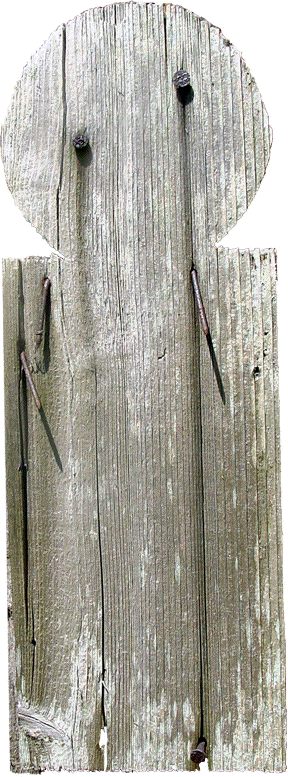

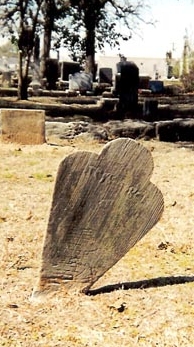




 This wooden marker for William Hardy (1890-1894) was erected as a temporary marker to be eventually replaced by a stone monument. It is the only wooden marker left in the cemetery and marks an earlier period in our local history. -
This wooden marker for William Hardy (1890-1894) was erected as a temporary marker to be eventually replaced by a stone monument. It is the only wooden marker left in the cemetery and marks an earlier period in our local history. -  Andersonville Cemetery
Andersonville Cemetery